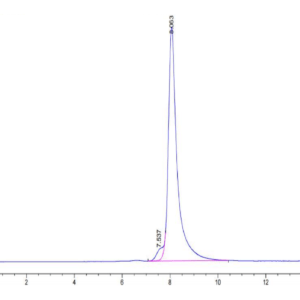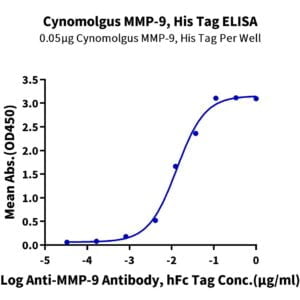| Weight | 1 lbs |
|---|---|
| Dimensions | 9 × 5 × 2 in |
| accession | Q08188 |
| express system | Baculovirus-Insect Cells |
| product tag | N-His |
| purity | > 95% as determined by Tris-Bis PAGE;> 95% as determined by HPLC |
| background | TGM3, encoded by the TGM3 gene, is widely expressed in the small intestine, brain, skin and mucosa. In the skin and mucosa, TGM3 is predominantly expressed in the suprabasal layers of the stratified squamous epithelium. It has been demonstrated that TGM3 is essential for epidermal terminal differentiation and formation of the cornified cell envelope through cross-linking structural proteins such as involucrin, loricrin and small proline-rich proteins. |
| molecular weight | The protein has a predicted MW of 78.23 kDa same as Tris-Bis PAGE result. |
| available size | 100 µg, 500 µg |
| endotoxin | Less than 1EU per μg by the LAL method. |

Human TGM3/Transglutaminase 3 Protein 2260
$315.00 – $1,050.00
Summary
- Expression: Baculovirus-Insect Cells
- Active: Yes (catalytic)
- Amino Acid Range: Ala2-Glu693
Human TGM3/Transglutaminase 3 Protein 2260
| protein |
|---|
| Size and concentration 100, 500µg and liquid |
| Form Liquid |
| Storage Instructions Valid for 12 months from date of receipt when stored at -80°C. Recommend to aliquot the protein into smaller quantities for optimal storage. Please minimize freeze-thaw cycles. |
| Storage buffer Shipped with dry ice. |
| Purity > 95% as determined by Tris-Bis PAGE |
| target relevance |
|---|
| TGM3, encoded by the TGM3 gene, is widely expressed in the small intestine, brain, skin and mucosa. In the skin and mucosa, TGM3 is predominantly expressed in the suprabasal layers of the stratified squamous epithelium. It has been demonstrated that TGM3 is essential for epidermal terminal differentiation and formation of the cornified cell envelope through cross-linking structural proteins such as involucrin, loricrin and small proline-rich proteins. |
| Protein names Protein-glutamine gamma-glutamyltransferase E (EC 2.3.2.13) (Transglutaminase E) (TG(E)) (TGE) (TGase E) (Transglutaminase-3) (TGase-3) [Cleaved into: Protein-glutamine gamma-glutamyltransferase E 50 kDa catalytic chain; Protein-glutamine gamma-glutamyltransferase E 27 kDa non-catalytic chain] |
| Gene names TGM3,TGM3 |
| Protein family Transglutaminase superfamily, Transglutaminase family |
| Mass 76632Da |
| Function Catalyzes the calcium-dependent formation of isopeptide cross-links between glutamine and lysine residues in various proteins, as well as the conjugation of polyamines to proteins. Involved in the formation of the cornified envelope (CE), a specialized component consisting of covalent cross-links of proteins beneath the plasma membrane of terminally differentiated keratinocytes. Catalyzes small proline-rich proteins (SPRR1 and SPRR2) and LOR cross-linking to form small interchain oligomers, which are further cross-linked by TGM1 onto the growing CE scaffold (By similarity). In hair follicles, involved in cross-linking structural proteins to hardening the inner root sheath. |
| Catalytic activity CATALYTIC ACTIVITY: Reaction=L-glutaminyl-[protein] + L-lysyl-[protein] = [protein]-L-lysyl-N(6)-5-L-glutamyl-[protein] + NH4(+); Xref=Rhea:RHEA:54816, Rhea:RHEA-COMP:9752, Rhea:RHEA-COMP:10207, Rhea:RHEA-COMP:14005, ChEBI:CHEBI:28938, ChEBI:CHEBI:29969, ChEBI:CHEBI:30011, ChEBI:CHEBI:138370; EC=2.3.2.13; Evidence=; |
| Subellular location Cytoplasm . |
| Structure Consists of two polypeptide chains, which are synthesized as a precursor form of a single polypeptide. |
| Post-translational modification Activated by proteolytic processing. In vitro activation is commonly achieved by cleavage with dispase, a neutral bacterial protease. Dispase cleavage site was proposed to lie between Ser-470 and Ser-471 (PubMed:8099584) or between Pro-465 and Phe-466 (PubMed:16565075). Physiological activation may be catalyzed by CTSL and, to a lesser extent, by CTSS, but not by CTSB, CTSD nor CTSV (PubMed:16565075). |
| Target Relevance information above includes information from UniProt accession: Q08188 |
| The UniProt Consortium |
Data
Publications
Publications
| pmid | title | authors | citation |
|---|---|---|---|
| We haven't added any publications to our database yet. | |||
Protocols
| relevant to this product |
|---|
Documents
| # | ||
|---|---|---|
| Please enter your product and batch number here to retrieve product datasheet, SDS, and QC information. | ||

















